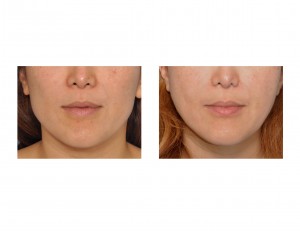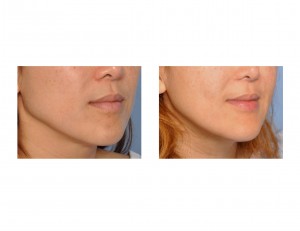Background: The frontal view of the face allows one to see its width from the forehead down to the jawline. This width and its proportion to the length of the face helps create an overall facial shape. It is generally acknowledged that there are seven basic facial shapes which for women an oval shape is more aesthetically desired while for men a more square shape may be preferred.

Reduction of the jaw angles is a well known surgical technique that is used for narrowing a wide lower face, most commonly done for Asian facial reshaping. Historically, jaw angle reduction was an amputation method removing the entire angle in an oblique fashion. While that may be effective in some patients, it is often a technique that is overused and can create undesired aesthetic consequences. (tissue sagging, steepening of the mandibular plane angle) This has led to less aggressive techniques where the angle shape is preserved and its thickness is reduced by a lateral corticotomy.
Case Study: This 33 year-old female was having multiple procedures for facial reshaping. One of the changes she wanted to make was a narrowing of her lower face. But she did not want to lose the shape of her jaw angle and did not want a ‘traditional’ jaw angle amputation technique.


Case Highlights:
1) Reduction of the posterior lower width of the face involves removal of a portion of the jaw angle…if it has adequate flare or bone thickness.
2) Jaw angles can be narrowed by either a full thickness (amputation) or a partial thickness reduction technique.
3) The width of the posterior lower face is a combination of both bone and soft tissue and bone reduction alone does not always guarantee a very visible narrowing effect.
Dr. Barry Eppley
Indianapolis, Indiana


